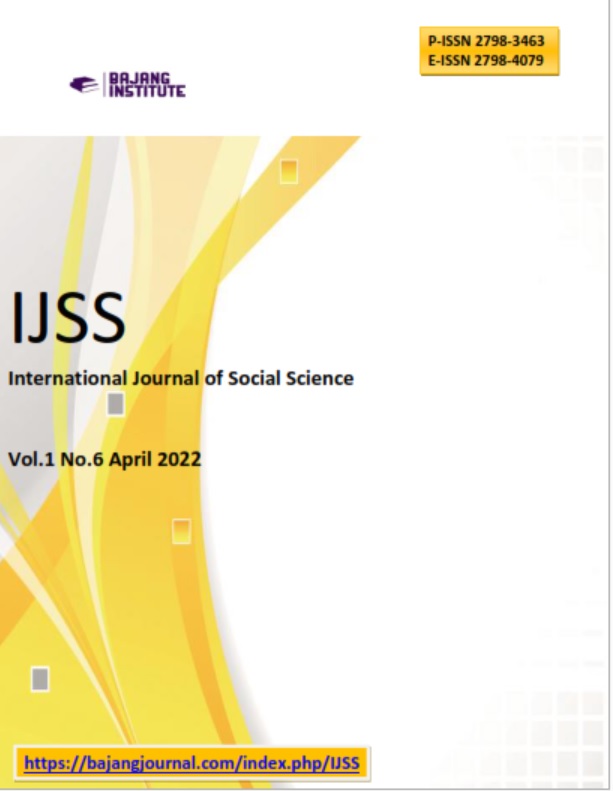ANALYSIS OF THE BADE WHEELED PHENOMENON IN THE NGABEN CEREMONY STRUCTURE IN BALI
DOI:
https://doi.org/10.53625/ijss.v1i6.1906Keywords:
Analysis Bade Wheeled Phenomenon Ngaben Ceremony Structure BaliAbstract
The purpose of the analysis of the Bade Wheeled Phenomenon in the Ngaben Ceremony Structure in Bali is to reveal the meaning of Wheeled Bade. Bade is known in traditional Balinese culture as an important tool in the Ngaben Ceremony in Bali. However, some Balinese people have replaced the word "bade" with "bade wheels" as a means of Ngaben Ceremony. The problem is centered on: 1) What is the meaning of "bade" in the Ngaben Ceremony?; 2) What is the meaning of "wheeled bade?" The analysis of the Bade Wheeled Phenomenon in the Ngaben Ceremony Structure in Bali has been completed using qualitative methods in the perspective of cultural studies. The technical design of this research is realized based on the non-positivistic paradigm with the help of a semiotic approach. All data was collected through observation and literature study. All data were analyzed in an interpretative qualitative manner using symbol theory and reception theory. The results of the study show that: 1) Ngaben using Bade has a socio-religious meaning for Hindus in Bali. Ngaben is always celebrated using Bade, accompanied by various forms of Hindu sacred ceremonies. Bade has cultural meaning as an instrumental of the pitra yadnya rite that can be useful in fostering kinship in Balinese society; 2) The phenomenon of wheeled bade in the structure of the Ngaben ceremony has added economic value to mediators and users. On the one hand, the wheeled Bade in the structure of the Ngaben Ceremony has reduced the meaning of sacredness and the meaning of solidarity. This happened along with the change in the instrumental meaning of Bade in the Ngaben ceremony.
References
Berg, Bruce L., Howard Lune. 2018. Qualitative Research Methods For The Social Sciences. Boston : Pearson.
Dharmayuda, I. M. (1995). Kebudayaan Bali: pra-Hindu, masa Hindu, dan Pasca Hindu. Denpasar: Kayumas Agung.
Kaler, I. G. (1993). Ngaben: Mengapa Mayat Dibakar? Denpasar : Yayasan Dharma Naradha.
Pradana, Gede Yoga Kharisma, I Nyoman Suarka, Anak Agung Bagus Wirawan, I Nyoman Dhana. (2016). Religious Ideology of The Tradition of The Makotek in The Era of Globalization. Electronic Journal of Cultural Studies, 9(1), 6-10.
Pradana, Gede Yoga Kharisma, Komang Shanty Muni Parwati. (2017). Local-Wisdom-Based Spa Tourism in Ubud Village of Bali, Indonesia. Russian Journal of Agricultural and Socio-Economic Sciences, 8(68), 188-196.
Pradana, Gede Yoga Kharisma, Komang Trisna Pratiwi Arcana. (2020). Hasil Pengelolaan Homestay Bercorak Budaya Tradisional Bali Ditengah Pengaruh Perkembangan Trend Millennial di Sektor Pariwisata. Jurnal Ilmiah Hospitality Management, 11(1), 1-12.
Pradana, Gede Yoga Kharisma, Ni Made Ruastiti. (2022). Imitating The Emancipation Of Hindu Female Characters In Balinese Wayang Legends. International Journal of Social Science, 5(1), 643-656. https://doi.org/10.53625/ijss.v1i5.1307.
Pradana, Gede Yoga Kharisma. (2012). Diskursus Fenomena Hamil di Luar Nikah dalam Pertunjukan Wayang Joblar. Electronic Journal of Cultural Studies, 1(2), 11-27.
Pradana, Gede Yoga Kharisma. (2018). Implications of Commodified Parwa Shadow Puppet Performance For Tourism in Ubud, Bali. Journal of Business on Hospitality and Tourism, 4(1), 70-79. DOI: http://dx.doi.org/10.22334/jbhost.v4i1.103.g111.
Pradana, Gede Yoga Kharisma. (2019). Sosiologi Pariwisata. Denpasar : STPBI Press.
Pradana, Gede Yoga Kharisma. (2021). Aplikasi Filosofi Tri Hita Karana Dalam Pemberdayaan Masyarakat Tonja di Denpasar. Jurnal Abdi Masyarakat, 1(2); 61-71. DOI : https://doi.org/10.22334/jam.v1i2.10.
Prihandini, A., & Fauzan, A. (2018). Deskripsi Sosial Masyarakat terhadap Gambar dan Tulisan yang Terdapat dalam Gerobak Truk. Al-Tsaqafa: Jurnal Ilmiah Peradaban Islam, Vol. 15, No. 1, 1-8.
Ramadhan, A. (2018). Representasi Gerobak Sepeda sebagai Alat Pengangkut Barang Bekas. Narada: Jurnal Desain & Seni, Vol. 5, Edisi. 2, 37-62.
Sobur, A. (2009). Analisis Teks Media: Suatu Pengantar untuk Analisis Wacana, Analisis Semiotik, dan Analisis Framing. Bandung: PT. Remaja Rosdakarya.
Sukrawati, N. M. (2019). Acara Agama Hindu. Denpasar : UNHI Press.
Suyoga, I. P. (2014). Arsitektur Bade: Transformasi Konsep Menuju Bentuk. Ubud, Gianyar, Bali: Yayasan Kryasta Guna.
Titib, I. M. (2003). Teologi & Simbol-Simbol dalam Agama Hindu. Surabaya: Paramita.
Tristaningrat, M. A. (2019). Analisis Panca Yadnya dalam Konteks Saguna Brahman dalam Menciptakan Aktivitas Sosial Budaya. Maha Widya Bhuwana, Vol. 2, No. 1, 57-68.
Wikarman, I. N. (2010). Ngaben (Upacara dari Tingkat Sederhana sampai Utama). Surabaya : Paramita.
Segara, I Nyoman Yoga. 2020. Bade Beroda : Transformasi dan Komodifikasi Budaya dalam Upacara Ngaben di Bali. Mudra Jurnal Seni Budaya, 35(1), 94-102.
Puspa, Ida Ayu Tary. 2019. Ngaben Sebagai Daya Tarik Wisata. Pariwisata Budaya : Jurnal Ilmiah Agama dan Budaya, 4(1), 37-45.
Suparta, I Made. 2015. Jenis Hiasan Tatahan Bade. Imaji, 8(1), 81-104.
Sudarsana, I Ketut. 2017. Interpretation Meaning of Ngaben for Krama Dadia Arya Kubontubuh Tirtha Sari Ulakan Village Karangasem District : Hindu Religious Education Perspective. Vidyotamma Sananta International of Hindu Science and Religious Studies, 1(1), 1-13.
Ernatip. 2018. Upacara Ngaben di Desa Rama Agung-Bengkulu Utara. Jurnal Penelitian Sejarah dan Budaya, 4(2), 1115-1133.

















